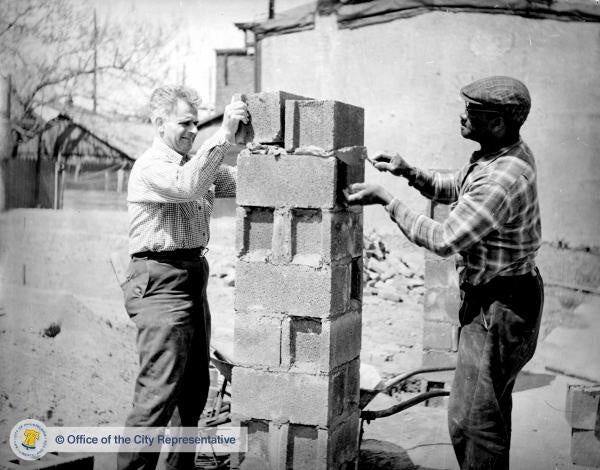Protecting a ‘potter’s field’ is focal point of development project in Germantown
The term “potter’s field” originates from a New Testament vignette involving a remorseful Judas attempting to return 30 pieces of silver to priests. The money was promptly taken to “the potter’s field, to be a burying place for strangers.” Americanized, the term refers to a burial ground for the unidentified or the indigent; it references land offering potter’s clay, but unfit for agriculture.
While not a new phrase—I’d first heard of it in 1999 when covering the burial of an unidentified German tourist who jumped to his death from the ninth floor of an Atlantic City casino’s parking garage—it has become the focal point of a debate regarding the demolition of the Queen Lane Apartments in Germantown.
When the city constructed a public-housing high-rise near West Queen Lane and Pulaski Avenue in 1955, the apartments and a playground were built on land that the Preservation Alliance for Greater Philadelphia says was purchased in 1755 as a burial ground for “all strangers, Negroes, and Mulattoes [who] die in any part of Germantown forever.”
What started as a battle over the size of a playground, which the PHA intends to construct as part of new housing units, rapidly evolved into an issue of protecting “hallowed ground.” It was mentioned briefly at a Dec. 7 community meeting as possible grounds to stop the project.
Within two weeks, a coalition of the Northwest Neighbors of Germantown, the Germantown Historical Society and Avenging the Ancestors Coalition (ATAC) was requesting a pre-construction archaeological study of the site.
“Prior to 1755 our ancestors were burnt, chopped up and fed to cattle, thrown in the river. So to implode that building and incinerate anything that is left is not respecting the dead,” said Lisa Hopkins of the Northwest Neighbors.
It is “very likely” that buried remains are still on site, said GHS urban archaeologist Alex Bartlett at that meeting.
An alternative construction plan had been offered and, on Jan. 5, the PHA said it would reconfigure its project to provide a longstanding tribute to those buried there. In coming weeks and months, the community and housing agency will bat around ideas about how best to commemorate the past while moving into the future.
Attorney Michael Coard of ATAC, which was instrumental in having the “President’s House” slave quarters recognized on Independence Mall, said last week he was surprised at how quickly efforts had galvanized behind the Germantown effort. He first mentioned it on his WURD-AM radio show in mid-December; the response was “overwhelming” from residents, callers and even station management.
“This is important because the history of Africans in America is based on speculation, with enslaved ancestors having no birth certificate, no proof of existence since they were bought and sold like a horse or a stable. We don’t know where we came from,” he said. “When we find out that there are people buried there around the 1750s, maybe we can learn their real names, their real history. This is important because it ends the disconnect and begins the connect. It’s a step backward going forward, as crazy as that may sound.”
Coard recalled the jealousy he harbored toward a classmate at Masterman High who could rattle off his great-grandfather’s life history, down to the house he lived in in Italy. “Maybe this Germantown African burial ground will be that step,” he said.
The potter’s field is different than the President’s House effort in that the stories of George Washington’s slaves were abstract, “but now we’ve got folks who lived in Germantown,” Coard said. “It’s a direct connection. It’s important. It’s real to people. … We’re [looking] to work with a respected archaeologist at the site, avenging and respecting our ancestors who may be buried there, but offering a place to reflect and mourn. If I had my druthers, it would be revered as hallowed ground.”
Just a day after Coard said that, the PHA acknowledged that he—and others—will have their druthers after all. This new historical monument in the most historic of American cities will be the point of discussion and celebration in the coming year and beyond.
WHYY is your source for fact-based, in-depth journalism and information. As a nonprofit organization, we rely on financial support from readers like you. Please give today.




